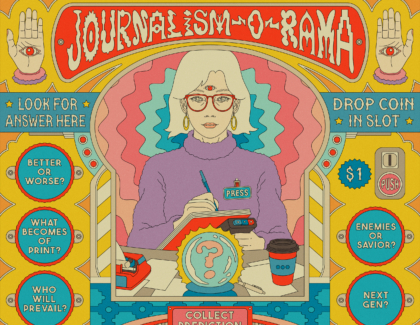Sign up for the daily CJR newsletter.
On a recent Sunday, as local officials in Bucks County, Pennsylvania, worked to certify election results, parishioners gathered for Spanish-language Mass at St. Charles Borromeo Parish in the town of Bensalem. The church, built of brick with a soaring wood ceiling, welcomes the breadth of Bucks, just east of Philadelphia’s most suburban neighborhoods: conservative and liberal, working class and impoverished, native born and migrant, US citizen and undocumented, from homes where people speak English and others in Spanish. As of November, it’s also Donald Trump terrain—just barely, as it came down to fewer than three hundred votes, with some districts determined by fewer than ten. The area is not, for all of its divisions and volatility, a news desert—there is much information to be had—but it can come up dry of facts, as much of the coverage comes from partisan media, some trafficking in fantasy. After Mass, the Reverend Philip M. Forlano, in his white vestment, said that he’d been avoiding cable news and instead tuned in to podcasts such as The Dark Horse, The Ricochet Podcast, and sometimes The Joe Rogan Experience, especially when Tulsi Gabbard and Robert F. Kennedy Jr. were on. “Trump is listening to the needs of the working person,” he said. The Democrats “are the party of the rich and educated, not the poor and working class.” Unchecked immigration was taxing America, the same as if guests overwhelm a host, he argued. “You can’t just give out to anybody who comes,” he added, “or else you’ll give away the store.”
José Hernandez, a sixty-year-old parishioner and native of El Paso, stood nearby, collecting donations, many of them from migrants from Mexico and Ecuador. He was not moved. Trump, he recalled, said, “‘They’re sending criminals, they’re sending rapists!’ It wasn’t true!” He’d been following news from the New York Times, the Washington Post, the networks, Telemundo, Univision. Through the church, he worked with undocumented people on their immigration paperwork and helped them learn to drive; the uncertainty of their futures persuaded him to vote for Kamala Harris. “Everybody has the right to survive,” he said. “You read the Bible. It talks about what is the most important commandment: love thy neighbor.” The Reverend Forlano countered, gently: “The unborn is your neighbor, too.”
Theirs was a civil disagreement amid a great deal of rancor across the state. “The whole political landscape has changed so much, and the way so many voted was more to do with how people get their information,” Larry King, a journalist for twenty-two years at the Philadelphia Inquirer, and then a Bucks County spokesman, told me. (He bears no relation to the TV host.) Bucks residents, he said, already know what they believe. Little could sway them. “People can pick and choose what social media sites, what far-right sites, they go to.” They can also decide to avoid the news, according to the Pew Research Center, which noted an overwhelming rejection of nightly broadcasts and legacy news outlets by US voters in the lead-up to the election. Americans were tuned out or turned off by reporting. Voters, and those who refused to vote, often relied on friends, and whatever they saw on social media, that affirmed their preexisting views.
In backing Trump, Bucks sided with a Republican for the first time since George H.W. Bush, a shift that reflects suburban trends: housing prices exploded during the pandemic, as people poured into the region—blue-collar, racially mixed, working-class stretches of Lower Bucks in the south, farmland in the north, and the wealthier and whiter townships of professionals and corporate workers in the center. In Levittown, the county’s famed postwar housing development, buyers are flipping ranch homes into mini-mansions and pricing them at more than five hundred thousand dollars. Commuters are frustrated by the steady surge in gas prices. In an area forged by generations of newcomers from Northern Ireland, Southern Italy, the former Soviet Union, and Central Asia, some residents have raised concerns with the number of people arriving from Central and South America. Students, anxious about their futures, are flocking to community colleges to learn practical trades such as 3D printing, culinary skills, and emergency management.
These may seem routine matters in America. In recent years, though, Bucks has become a hub of Trump-brand hysterics, generating civic unrest like few other suburban centers in the country. According to preliminary George Washington University research, Bucks produced more January 6 insurrection defendants than all but two other US counties. School districts in Bucks erupted into fights over pandemic mask requirements and school reopenings; national groups fanned in, escalating the conflict, pushing for book bans and an end to support of LGBTQ kids. Paul Martino, a Doylestown venture capitalist, poured hundreds of thousands of dollars into races for conservative candidates running for local school boards. Five of the state’s fake electors, recruited by Trump allies to claim he won in 2020, returned to the task this year. That includes Bucks’s sitting Republican Committee chairwoman.
With Pennsylvania inundated by national coverage and candidate ads, Matthew K. Seibert, a media librarian at Bucks County Community College in Newtown, observed that many students didn’t know where to turn for reputable coverage, and many lacked interest in electoral politics altogether. “We have a news economy without editors. No gatekeepers,” he said. “Without consensus being drawn, what is the truth?” he wondered. “You have information overload and nothing can be verified.”
The state’s major news outlet, The Inquirer, a former Knight Ridder, then McClatchy property, now owned by a local nonprofit, Lenfest Institute, once had upwards of twenty-five people working in Bucks County. That included staff editors, photographers, and reporters who covered the school board, township and county commissioner meetings, police, and courts. “Their presence means something—you built relationships with people,” King said. “When I took the buyout, in 2011, I was the entire Bucks County staff, working out of my spare bedroom.” The paper now has no reporter assigned to cover Bucks County, but relies on beat writers—education, for one—who are spread across the southeast corner of the state. Gannett owns what remains of two newspapers based in Bucks. After cutting staff, and moving coverage to a digital site called phillyburbs.com, the enterprise employs twelve journalists to cover the region, including sports reporters.
Replacing traditional daily coverage has been a surfeit of opinion and argument. Broad + Liberty, an outlet that aims to lure “free thinkers,” is a nonprofit led by Terrence Tracy Jr., a retail executive and onetime Republican candidate for Philadelphia City Council. Delaware Valley Journal, a platform for conservative causes and activists, is published by InsideSources, a corporation run by Michael Graham, a conservative Boston Herald columnist and talk radio veteran. Bucks County Beacon, online since 2021 to address the dearth of local news, positions itself as a progressive site that invites opinion from activists and calls out lapses in local coverage—and so it is a touch ironic that one of its chief writers lives in Guatemala and watches livestreams of county board meetings. Cyril Mychalejko, the editor in chief, who grew up in Bucks, got the job, he said, because he kept criticizing the “right-wing biases” of the Gannett-owned Bucks dailies. “I see this as movement media,” he told me. The outlet’s owner, Emily Smith, is a realtor, graphic designer, and member of the Camp Hill Borough Council. The Beacon is supported by a donor; neither Smith nor Mychalejko would disclose the person’s name.
Partisanship and the loss of local coverage generated conflict during the pandemic, when, months into social distancing and keeping children at home, Bucks became a national symbol of societal breakdown, targeted by far-right conservatives. Neighbors turned on school boards, and then each other, over policies that governed masks, vaccines, and in-person classes. At one point, several parents of disabled children sued to compel districts to enforce mandatory masking requirements. In a separate lawsuit, a few parents claimed that masks caused anxiety and depression, and violated their children’s religious and civil rights. Suddenly, people began to speak at meetings denouncing critical race theory. Local mothers formed a chapter of Moms for Liberty, since named an anti-government organization by the Southern Poverty Law Center. For a while, the board meetings received little coverage; the winnowing of local reporters meant that any resident trying to generate attention was “screaming from rooftops to nobody,” Diana Leygerman, a teacher and eventual Democratic organizer from Warwick Township, told me.
When Leygerman realized that disrupting school meetings to raise culture war concerns was one of the group’s tactics, she began to share her concerns on X. The grievances of Moms for Liberty Bucks grew; school board meetings became a vast battleground—over LGBTQ rights, book censorship, and other right-wing grievances. Once anti-mask parents accused pro-mask neighbors of being child abusers and murderers, the Bucks school board received daily coverage by most local media and, increasingly, by national outlets. “I think part of what fueled the fire, there were these groups saying who to trust and who not to trust. And powerful figures were spouting misinformation about certain media,” Emily Rizzo, a journalist who covered Bucks schools at the time, told me. “There was a lot of fear around.”
In the fall of 2023, voters threw the most vitriolic conservative parents out of school boards in Pennsylvania, New Jersey, Virginia, and elsewhere. Rizzo, who writes for the nonprofit Kensington Voice, a hyperlocal outlet where she covers an impoverished neighborhood in Philadelphia, said she aimed to report on what was happening outside of government meetings, by exposing the conservative groups that advised local officials and interviewing parents, teachers, and LGBTQ students about the climate in schools. But she wondered if, by focusing on the culture war, journalists might have inflamed community divides. She’s partial toward solutions journalism, she said, “not just quoting the most vocal people at a community meeting but thinking about the issues about that and how they impact everyone across the board.”
Tom Sofield, who is thirty-three, remembers a wealth of local weeklies when he grew up in Bucks. Now some towns have “no coverage at all,” he said. That led him in 2013 to launch LevittownNow.com, a hyper-local outlet that produces meat-and-potatoes coverage of township and county meetings, fires, and business closings in Lower Bucks. He is publisher, writer, editor, and ad seller, with two sister sites, which report on the communities of Newtown and New Hope. Research conducted before the pandemic told him that 82 percent of Levittown residents were reading the site at least once a week. “I am concerned about who is not reading us, as a journalist and businessperson,” he said.
He sees many people trade in rumor. October 24 was a case in point. That day, someone alerted him to a viral video posted on X of someone destroying county mail-in ballots for Trump. Soon, people began texting and calling him, concerned. “The folks in politics immediately knew it was fake, but readers were asking if it was true and many were legitimately unsure,” Sofield said. He didn’t know: Was it someone local trying to sow discord? A prankster? Some foreign government or group? The Bucks County Board of Elections did not need to do much investigating to declare the video a hoax. The original post came from an X account that shared baseless QAnon conspiracy theories that claimed Trump antagonists ate babies and harvested a chemical compound from their bodies. Sofield described how the video had been debunked. The next day, US intelligence agencies attributed the video to Russian state actors. Sofield was happy to post the Associated Press story, which gave him time to report that a local TGI Fridays had closed.
Leading up to Election Day, as more of the national presidential campaigns leaned on Pennsylvania voters, residents viewed social issues, such as immigration and abortion rights, through the prism of economics. The prevailing sentiment shared by Bucks County voters in interviews was that they are feeling beleaguered by rising prices and that the media’s fears of Trump’s fascist threats, suppression of women’s rights, and abandonment of democracy abroad were overblown.
Jose Peña, a former taco truck operator who moved to Bucks County around election time to find an affordable house to buy for his wife and daughter, comes from a working-class Democratic family in Queens. This year, “I’m a traitor,” he said. “Ultimately, I feel it was inflation. Everything’s been soaring.” Peña had spent a weekend driving his family around in their Jeep Gladiator to visit house openings in Levittown, including some priced at more than half a million dollars. Still, they were cheaper than what he could buy back home. He followed the news on CNN, NBC, and Telemundo, along with the televised debates. Some of the new immigrants in New York aggravated him, he said. He had seen some engaged in petty crime, grabbing clothing from stores. “I think they should do a better job of checking people’s criminal history,” he told me. “It puts a bad reputation for all of us.”
The election year rancor turned off many students enrolled at Bucks County Community College in Newtown. Jeffrey Bakeoven, an eighteen-year-old first-year student from Philadelphia, said he and many students sat out the election. Dissuaded by the perceived bias in routine news coverage, he paid attention to debates about abortion and LGBTQ issues on Instagram, TikTok, and YouTube. Many of his family members voted for Trump. “I hate political talk,” Bakeoven, a cybersecurity major, said. “It splits people. I’m into unity.”
Has America ever needed a media defender more than now? Help us by joining CJR today.







